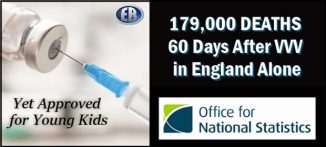
British children up to 52 times more likely to die following a COVID shot: gov’t report
Data from Britain’s Office for National Statistics show a stark increase in deaths among children both single- and double-jabbed compared to their un-jabbed counterparts.
DAVID McLOONE for LIFESITE NEWS
LONDON – Britain’s Office for National Statistics (ONS) has released data indicating that children who received the COVID-19 jabs have suffered a death rate 54 times greater than that of their un-jabbed counterparts.
In December, the ONS published age-standardized data on the mortality rates of individuals in 5-year age sets in Britain, grouped by their “vaccination” status for the COVID-19 shots. The data accounts for the period from January 1 to October 31, 2021.
The rate per 100,000 person-years delineation is used in preference over the simpler 100,000 population calculation to better represent the mortality rates over a specific period of time, as people in one “vaccination” group – such as un-jabbed, single-jabbed, and double-jabbed – soon move into the next group.
Table 9 of the ONS report shows the “deaths and person-years by vaccination status and five-year age group” for the entire ten-month period. According to the report, the un-jabbed 10–14-year-old group represents 2,094,711 person-years, and the 15–19 age set 1,587,072 person-years over the same time.

From the above table the 100,000 person-years calculation can be made, with the younger group coming out at 20.9 un-jabbed per 100,000 person-years and the older group at 15.9. Following this, the mortality rate per 100,000 person-years is worked out by dividing the number of deaths within each group by the 100,000 person-years calculation.
The result is that for the 10–14 year group, the un-jabbed mortality per 100,000 person-years is 4.6 while the un-jabbed mortality rate per 100,000 person-years for the 15–19 group is 10.1.
Using the same data set and calculation, the mortality rate for 10–14-year-olds who received one dose of the jabs suffered a 45.1 per 100,000 person-years death rate, while 15–19-year-olds with one jab suffered 18.3 deaths per 100,00 person-years.


Among those who received two doses of the COVID jabs in both young age groups, the death rates were higher still, with 32.9 deaths per 100,000 person-years among the 15–19 age group and a staggering 238.4 deaths per 100,000 person-years among 10–14-year-olds in the U.K.
10–14-year-olds, on the other hand, run the risk of dying almost by a factor of ten following the first dose while the second dose brings a 51.8 times greater risk of death than if they had remained un-jabbed.
On average, it means that children between 10 and 19 years of age who had received at least one shot of the COVID jabs had a 3.7 times greater chance of dying between January and October last year.
************
Source

••••
The Liberty Beacon Project is now expanding at a near exponential rate, and for this we are grateful and excited! But we must also be practical. For 7 years we have not asked for any donations, and have built this project with our own funds as we grew. We are now experiencing ever increasing growing pains due to the large number of websites and projects we represent. So we have just installed donation buttons on our websites and ask that you consider this when you visit them. Nothing is too small. We thank you for all your support and your considerations … (TLB)
••••
Comment Policy: As a privately owned web site, we reserve the right to remove comments that contain spam, advertising, vulgarity, threats of violence, racism, or personal/abusive attacks on other users. This also applies to trolling, the use of more than one alias, or just intentional mischief. Enforcement of this policy is at the discretion of this websites administrators. Repeat offenders may be blocked or permanently banned without prior warning.
••••
Disclaimer: TLB websites contain copyrighted material the use of which has not always been specifically authorized by the copyright owner. We are making such material available to our readers under the provisions of “fair use” in an effort to advance a better understanding of political, health, economic and social issues. The material on this site is distributed without profit to those who have expressed a prior interest in receiving it for research and educational purposes. If you wish to use copyrighted material for purposes other than “fair use” you must request permission from the copyright owner.
••••
Disclaimer: The information and opinions shared are for informational purposes only including, but not limited to, text, graphics, images and other material are not intended as medical advice or instruction. Nothing mentioned is intended to be a substitute for professional medical advice, diagnosis or treatment.



